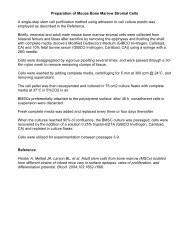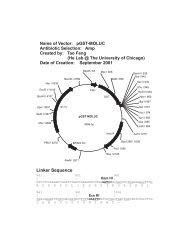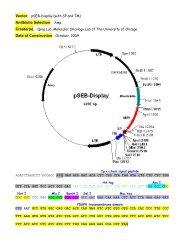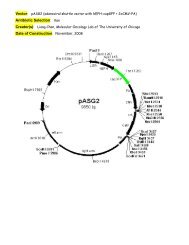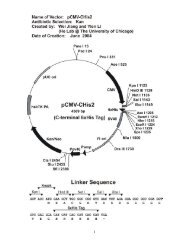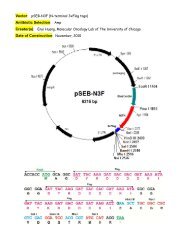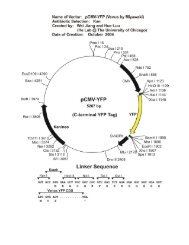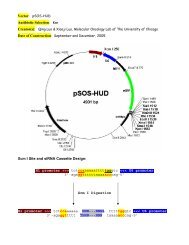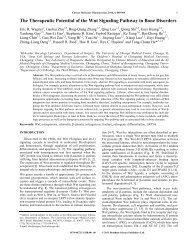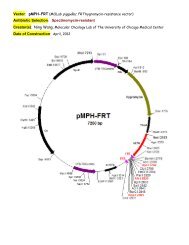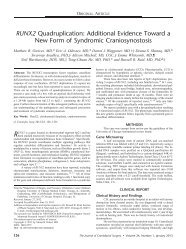Characterization of the distinct orthotopic bone-forming activity of 14 ...
Characterization of the distinct orthotopic bone-forming activity of 14 ...
Characterization of the distinct orthotopic bone-forming activity of 14 ...
You also want an ePaper? Increase the reach of your titles
YUMPU automatically turns print PDFs into web optimized ePapers that Google loves.
tested in clinical trials. 25–27 In addition to <strong>the</strong> direct<br />
application <strong>of</strong> recombinant BMP proteins, numerous<br />
reports have confirmed <strong>the</strong> ability <strong>of</strong> adenoviral or<br />
retroviral vector-mediated gene transfer <strong>of</strong> several BMPs<br />
to induce <strong>bone</strong> formation in animal models. 18,20,21,23,28–44<br />
Although a plethora <strong>of</strong> studies have demonstrated <strong>the</strong><br />
ability <strong>of</strong> several BMPs, mostly BMP-2 and BMP-7, to<br />
promote osteogenesis, it is unclear whe<strong>the</strong>r or not BMPs<br />
o<strong>the</strong>r than those currently being tested in clinical trials<br />
are more potent stimulators <strong>of</strong> new <strong>bone</strong> formation.<br />
Thus, it is important to conduct a comprehensive<br />
comparative analysis <strong>of</strong> <strong>the</strong> in vivo osteogenic <strong>activity</strong><br />
<strong>of</strong> all BMPs. This line <strong>of</strong> investigation has been<br />
hampered by <strong>the</strong> fact that recombinant proteins are<br />
ei<strong>the</strong>r not biologically active or not available for all<br />
BMPs. We have recently constructed a panel <strong>of</strong> recombinant<br />
adenoviral vectors that express <strong>the</strong> <strong>14</strong> types <strong>of</strong><br />
human BMPs (BMP-2–BMP-15). 45 Recombinant adenoviral<br />
vectors are ideal for this line <strong>of</strong> investigation for<br />
following reasons. 46–51 First, adenoviral vectors can<br />
transduce osteoblast progenitor cells with high efficiency.<br />
Second, <strong>the</strong> biologically active BMPs are continuously<br />
produced inside mammalian cells. Third,<br />
BMP-mediated <strong>bone</strong> osteoblast differentiation does not<br />
require long-term expression. Fourth, adenoviral vectors<br />
can be used in both in vitro and in vivo studies. In this<br />
study, we sought to carry out a comprehensive analysis<br />
<strong>of</strong> <strong>the</strong> <strong>distinct</strong> in vivo <strong>bone</strong>-<strong>forming</strong> <strong>activity</strong> <strong>of</strong> <strong>the</strong> <strong>14</strong><br />
types <strong>of</strong> human BMPs. Using an <strong>orthotopic</strong> ossification<br />
animal model, we demonstrate that BMP-2, BMP-6, and<br />
BMP-9 (BMP-7 to a lesser extent) are <strong>the</strong> most potent<br />
osteoinductive BMPs. Our findings strongly suggest<br />
that, in addition to BMP-2 and BMP-7 that are currently<br />
used in clinical trails, BMP-6 and BMP-9 could represent<br />
The in vivo osteogenic <strong>activity</strong> <strong>of</strong> <strong>14</strong> BMPs<br />
Q Kang et al<br />
equally, if not more effective osteogenic factors for <strong>bone</strong><br />
regeneration in a clinical setting.<br />
Results<br />
Distinct ability to induce an osteogenic marker, alkaline<br />
phosphatase (ALP), by <strong>14</strong> BMPs in <strong>the</strong> osteoblast<br />
progenitor C2C12 cells in vitro<br />
In order to comprehensively analyze <strong>the</strong> <strong>distinct</strong> osteogenic<br />
<strong>activity</strong> <strong>of</strong> BMPs, we have recently constructed a<br />
panel <strong>of</strong> recombinant adenoviral vectors that express <strong>the</strong><br />
<strong>14</strong> types <strong>of</strong> human BMPs, designated as AdBMPs. 45 As<br />
shown in Figure 1a, <strong>the</strong> level <strong>of</strong> transgene expression <strong>of</strong><br />
<strong>the</strong> AdBMPs were in general comparable (ie, o2-fold<br />
difference among different BMPs), as demonstrated by<br />
RT-PCR analysis. These PCR products should be specifically<br />
derived from <strong>the</strong> adenoviral vector-mediated<br />
expression (ra<strong>the</strong>r than from <strong>the</strong> endogenous genes), as<br />
<strong>the</strong> 3 0 -end primer was derived from <strong>the</strong> SV40 poly-A<br />
cassette. Using <strong>the</strong>se adenoviral vectors, we have<br />
recently demonstrated that BMPs displayed a <strong>distinct</strong><br />
ability to induce osteoblast differentiation <strong>of</strong> mesenchymal<br />
progenitor cells in vitro. 45 In this study, we sought to<br />
determine <strong>the</strong> relative in vivo osteogenic <strong>activity</strong> <strong>of</strong> <strong>the</strong> <strong>14</strong><br />
types <strong>of</strong> BMPs. We first tested <strong>the</strong> ability <strong>of</strong> individual<br />
AdBMPs to induce <strong>the</strong> earlier osteogenic marker alkaline<br />
phosphatase in <strong>the</strong> C2C12 line, which is myoblastic and<br />
can be trans-differentiated into osteoblast progenitors<br />
upon BMP stimulation. As shown in Figure 1b, ALP<br />
<strong>activity</strong> was remarkably induced by five <strong>of</strong> <strong>the</strong> <strong>14</strong> BMPs<br />
at four days after AdBMP infections. Among <strong>the</strong><br />
five osteogenic BMPs, BMP-2, BMP-6, and BMP-9<br />
induced <strong>the</strong> ALP <strong>activity</strong> to a much greater extent<br />
1313<br />
Figure 1 Induction <strong>of</strong> alkaline phosphatase <strong>activity</strong> by <strong>the</strong> <strong>14</strong> types <strong>of</strong> human BMPs in C2C12 cells. (a) Relative level <strong>of</strong> AdBMP-mediated transgene<br />
expression. C2C12 cells were infected with AdBMPs or AdGFP for 40 h. Total RNA was isolated and converted into cDNA products by reverse<br />
transcription, which were used for RT-PCR reactions using BMP-specific primers (5 0 -end) and a 3 0 -end primer derived from SV40 polyA. Resultant<br />
products ranged from 500 to 600 bps (indicated by arrows). ‘+’, PCR products from +RT reactions <strong>of</strong> <strong>the</strong> original cDNA syn<strong>the</strong>sis; ‘ ’, PCR products from<br />
RT reactions <strong>of</strong> <strong>the</strong> original cDNA syn<strong>the</strong>sis; ‘M’, 1-Kb Plus ladder from Invitrogen; ‘G’, AdGFP; ‘2–15’, AdBMP-2 to AdBMP-15. (b) Subconfluent<br />
C2C12 cells were infected with AdBMPs and <strong>the</strong> control AdGFP. At 4 days after infection, cells were lysed for colorimetric assays <strong>of</strong> alkaline phosphatase<br />
<strong>activity</strong> using p-nitrophenyl phosphate as a substrate. Representative results from at least three independent experiments are shown. See Materials and<br />
methods for details.<br />
Gene Therapy



